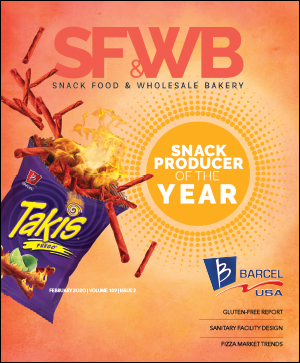When it comes to belts and conveyors, bakers and snack manufacturers want quickness and efficiency.

Nothing annoys plant managers more than unnecessary downtime, especially when it comes to something as seemingly simple as belts and conveyors. At best, it’s downright irritating.
In a worse case scenario, it can wreak havoc on the company’s bottom line and possibly result in interruptions in customer service, which every company strives to avoid at all costs.
That’s why manufacturers of snacks and baked goods are willing to invest a little bit more for durable systems that improve overall plant efficiencies. In addition, the focus on keeping their operations up and running is sparking a growing number of technical advances in belting and conveyor designs.
Responding to overall industry concerns about belt handling and issues with belts catching and tangling, for instance, Wire Belt rolled out its C-CureEdge, which is part of a latest development of its Flat-Flex style of belting, says Jamie Adams, marketing specialist for the Londonderry, N.H.-based company.
Wire Belt’s C-CureEdge c-shaped end loops, she adds, help to eliminate the “zipper effect” of belts tangling during unrolling and re-rolling of belts. They also increase safety and improve productivity.
“We realized that many plants cannot afford to have downtime from two conveyor belts catching during tight transfers,” she notes. “Wire Belt’s C-CureEdge patented end loops can help to lessen the chance of this occurring. C-CureEdge diminishes the opportunity for damage to conveying lines and minimizes the risk of accidents from sharp or burred open ends.”
Berndorf Belt Technology USA also focuses on reducing downtime with various service tools such as its new cutting and welding devices to expedite repairs and facilitate installations, says Daniela Weiszhar, marketing manager for the Elgin, Ill.-based company.
To produce high-quality products in a consistent manner, bakery facilities require dark and uniform belts. In addition, Weiszhar notes, the trend in the baking industry has been toward wider and longer belts, and Berndorf has belts, terminals and tracking systems in ovens in which the belt is nearly 2.5 meters wide.
For every manufacturer, durability remains the highest criteria for belts and conveyors. The Omni-Pro by Ashworth Bros., based in Winchester, Va., offers several features that increase the belt’s strength and allow it to run smoother with less system wear, says Marty Tabaka, sales director.
Specifically, the belt’s zero-tension design allows for higher load-bearing capacity while the company’s patented coining process prevents breaking wear, reduces belt elongation and increases belt life. Additionally, the system’s 360-degree buttonless weld is free from surface imperfections and crevices, which can improve hygienic characteristics by eliminating the possibility of bacteria entrapments.
For snack producers, some of their production needs such as potato receiving, processing and packaging are industry specific, says Job Dehorta, snack and tortilla segment leader for Intralox, Harahan, La. To produce their products, these manufacturers require delicate product handling, efficient drainage, ambient air cooling, tight transfers, bucket elevators, abrasion resistance and more.
Intralox’s bucket belt system helps reduce product loss and provides extended belt life, reduced scheduled downtime and increased throughput, Dehorta notes.
However for packaging handling, company’s big news is its award-winning Activated Roller Belt technology, which can enhance productivity, eliminate unnecessary labor costs and reduce operational expenses in a variety of back-of-the-plant applications.
“Snack processors can save money by eliminating line stoppages and other case handling challenges,” Dehorta says.
To quickly change product heights in the packaging area without conveyor-to-conveyor transfers, Dorner Manufacturing rolled out a flexible conveyor platform called the Z-Frame for its QWIK Conveyor 5200 series. Because the Z-Frame is integrated into a single conveyor system, producers avoid the extra costs associated with additional pulleys and drives, says Glenn Schultz, vice president of engineering for the Hartland, Wis.-based company.
QWIK series key features include modular, 15-degree curve segments for easy reconfiguration and a completely contained belt that eliminates catenary sag and reduces pinch points. The conveyors can be made at lengths up to 100 ft. and operate at speeds at 250 ft. per minute.
Overall, every company just wants its products to travel quickly through their operations with as little disruptions as possible. In the end, when it comes to belts and conveyors, their attitude is simply “move it or lose it.”
Editor’s Note: For more information on belts and conveyors, check out our online Buyer’s Guide at www.snackandbakery.com.
Photo courtesy of Wire Belt Co.







